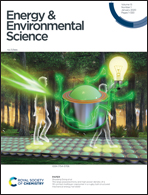Superior efficient rechargeable lithium–air batteries using a bifunctional biological enzyme catalyst†
Abstract
A biological enzyme – Laccase from Trametes versicolor (LacTv) – has been recognized as a highly efficient bifunctional catalyst in a rechargeable lithium–air battery system whose intrinsic pH change during discharge/charge can regulate the in situ recovery of the enzyme, making them an in situ synergistic match, enabling the battery to offer an extraordinarily flat discharge voltage of ∼3.75 V for 120 h, and remarkable durability (cycling steadily over 1100 h) with a narrow voltage gap of ∼0.24 V.



 Please wait while we load your content...
Please wait while we load your content...